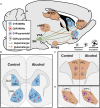Neural Mechanisms Underlying the Rewarding and Therapeutic Effects of Ketamine as a Treatment for Alcohol Use Disorder
- PMID: 33362485
- PMCID: PMC7759199
- DOI: 10.3389/fnbeh.2020.593860
Neural Mechanisms Underlying the Rewarding and Therapeutic Effects of Ketamine as a Treatment for Alcohol Use Disorder
Abstract
Alcohol use disorder (AUD) is the most prevalent substance use disorder and causes a significant global burden. Relapse rates remain incredibly high after decades of attempting to develop novel treatment options that have failed to produce increased rates of sobriety. Ketamine has emerged as a potential treatment for AUD following its success as a therapeutic agent for depression, demonstrated by several preclinical studies showing that acute administration reduced alcohol intake in rodents. As such, ketamine's therapeutic effects for AUD are now being investigated in clinical trials with the hope of it being efficacious in prolonging sobriety from alcohol in humans (ClinicalTrials.gov, Identifier: NCT01558063). Importantly, ketamine's antidepressant effects only last for about 1-week and because AUD is a lifelong disorder, repeated treatment regimens would be necessary to maintain sobriety. This raises questions regarding its safety for AUD treatment since ketamine itself has the potential for addiction. Therefore, this review aims to summarize the neuroadaptations related to alcohol's addictive properties as well as ketamine's therapeutic and addictive properties. To do this, the focus will be on reward-related brain regions such as the nucleus accumbens (NAc), dorsal striatum, prefrontal cortex (PFC), hippocampus, and ventral tegmental area (VTA) to understand how acute vs. chronic exposure will alter reward signaling over time. Additionally, evidence from these studies will be summarized in both male and female subjects. Accordingly, this review aims to address the safety of repeated ketamine infusions for the treatment of AUD. Although more work about the safety of ketamine to treat AUD is warranted, we hope this review sheds light on some answers about the safety of repeated ketamine infusions.
Keywords: addiction; alcohol use disorder (AUD); depression; ketamine; mechanisms.
Copyright © 2020 Strong and Kabbaj.
Conflict of interest statement
The authors declare that the research was conducted in the absence of any commercial or financial relationships that could be construed as a potential conflict of interest.
Figures

Similar articles
-
On the safety of repeated ketamine infusions for the treatment of depression: Effects of sex and developmental periods.Neurobiol Stress. 2018 Sep 21;9:166-175. doi: 10.1016/j.ynstr.2018.09.001. eCollection 2018 Nov. Neurobiol Stress. 2018. PMID: 30450382 Free PMC article. Review.
-
Sex and Individual Differences in Alcohol Intake Are Associated with Differences in Ketamine Self-Administration Behaviors and Nucleus Accumbens Dendritic Spine Density.eNeuro. 2019 Dec 4;6(6):ENEURO.0221-19.2019. doi: 10.1523/ENEURO.0221-19.2019. Print 2019 Nov/Dec. eNeuro. 2019. PMID: 31740575 Free PMC article.
-
Therapeutic potential of ketamine for alcohol use disorder.Neurosci Biobehav Rev. 2021 Jul;126:573-589. doi: 10.1016/j.neubiorev.2021.05.006. Epub 2021 May 11. Neurosci Biobehav Rev. 2021. PMID: 33989669 Review.
-
The therapeutic use and efficacy of ketamine in alcohol use disorder and alcohol withdrawal syndrome: a scoping review.Front Psychiatry. 2023 Apr 27;14:1141836. doi: 10.3389/fpsyt.2023.1141836. eCollection 2023. Front Psychiatry. 2023. PMID: 37181899 Free PMC article.
-
Ketamine Modulates the Neural Correlates of Reward Processing in Unmedicated Patients in Remission From Depression.Biol Psychiatry Cogn Neurosci Neuroimaging. 2022 Mar;7(3):285-292. doi: 10.1016/j.bpsc.2021.05.009. Epub 2021 Jun 11. Biol Psychiatry Cogn Neurosci Neuroimaging. 2022. PMID: 34126264
Cited by
-
Ketamine plus Alcohol: What We Know and What We Can Expect about This.Int J Mol Sci. 2022 Jul 15;23(14):7800. doi: 10.3390/ijms23147800. Int J Mol Sci. 2022. PMID: 35887148 Free PMC article. Review.
-
The Therapeutic Potential of Psychedelics in Treating Substance Use Disorders: A Review of Clinical Trials.Medicina (Kaunas). 2025 Feb 6;61(2):278. doi: 10.3390/medicina61020278. Medicina (Kaunas). 2025. PMID: 40005395 Free PMC article.
-
Effect of ketamine on binge drinking patterns in crossed high alcohol-preferring (cHAP) mice.Alcohol. 2021 Dec;97:31-39. doi: 10.1016/j.alcohol.2021.09.004. Epub 2021 Sep 20. Alcohol. 2021. PMID: 34547429 Free PMC article.
-
Effects of psychedelics on opioid use disorder: a scoping review of preclinical studies.Cell Mol Life Sci. 2025 Jan 21;82(1):49. doi: 10.1007/s00018-024-05519-2. Cell Mol Life Sci. 2025. PMID: 39833376 Free PMC article.
-
Ketamine Treatment for Alcohol Use Disorder: A Systematic Review.Cureus. 2023 May 3;15(5):e38498. doi: 10.7759/cureus.38498. eCollection 2023 May. Cureus. 2023. PMID: 37273364 Free PMC article. Review.
References
-
- Allen-Gipson D. S., Jarrell J. C., Bailey K. L., Robinson J. E., Kharbanda K. K., Sisson J. H., et al. . (2009). Ethanol blocks adenosine uptake via inhibiting the nucleoside transport system in bronchial epithelial cells. Alcohol. Clin. Exp. Res. 33, 791–798. 10.1111/j.1530-0277.2009.00897.x - DOI - PMC - PubMed
-
- American Psychiatric Association (2013). Diagnostic and Statistical Manual of Mental Disorders. 5th Edn. Arlington, VA: Author.
Associated data
Grants and funding
LinkOut - more resources
Full Text Sources
Medical
Research Materials
Miscellaneous

